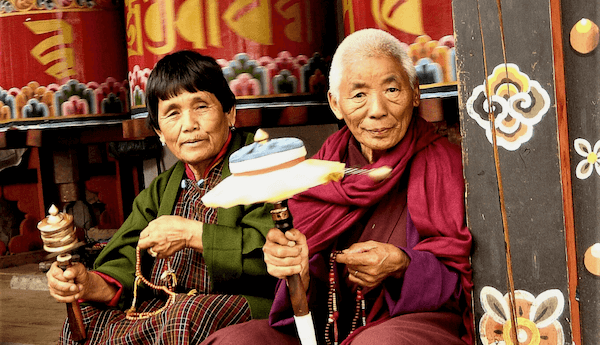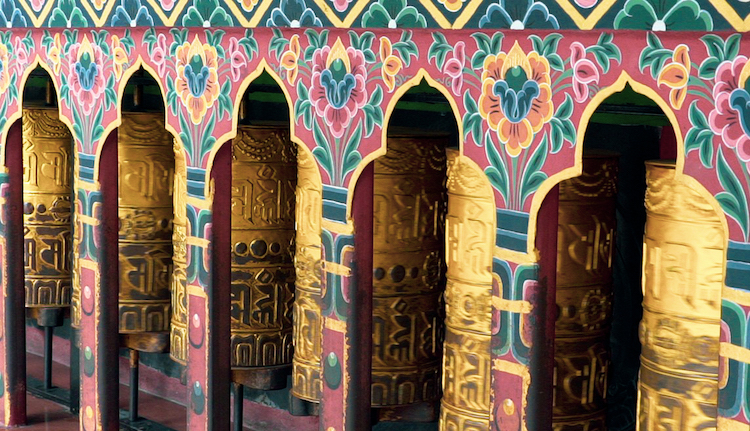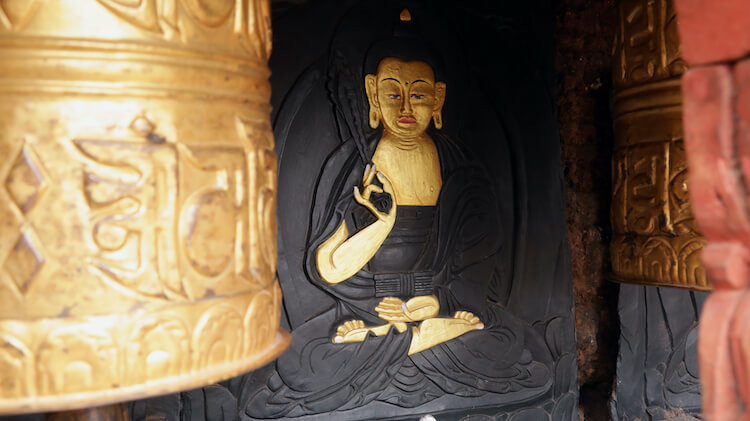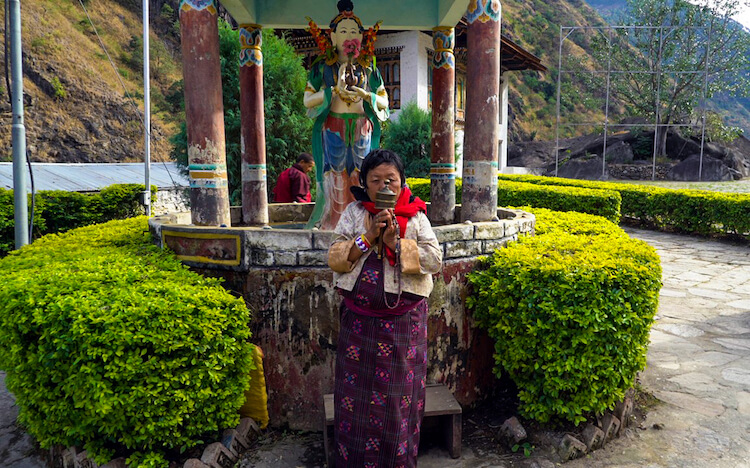
Birth of Buddhism
Buddhism is a philosophy of life, rather than just a religion. Founded by Siddhartha Gautama 2500 years ago, Buddhism stands today as one of the major World religions.
Siddhartha was born a Prince in 624 BC in a place called Lumbini (now in Nepal). On strolls outside the Palace doors his encounters with living beings trapped in the vicious circle of life, death and suffering, made the compassionate Prince resolve, to free them from this suffering. Knowing only an enlightened one will have the wisdom for this, he left the luxury of his palace and through various trials and errors choose a 'middle path' – an existence between two extremes, without indulgences but also without deprivation. After many years of wandering, searching, learning, he is said to have found enlightenment while meditating under a Bodhi Tree in Bodh Gaya (India) on a full moon day. He was thus named “Buddha – The Enlightened One”. Siddhartha the Prince, of course, was the chosen one, who was full of his own miracle powers. It is believed, on the 49th day after attaining Enlightenment, the Hindu Gods Brahma and Indra requested him to arise from his meditative form and turn the Wheel of Dharma – thus began the teachings of Buddha. He gave eighty-four thousand teachings. These teachings and their inner realizations of them constitute Buddhism.

Sects and Schools of Buddhism
After The Buddha passed on, his disciples took the baton forward. As years went by many sects and forms of Buddhism came into being, among them the three mains were:
Theravada Buddhism – prevalent in Thailand, Sri Lanka, Cambodia, Laos, and Burma
Mahayana Buddhism – prevalent in China, Japan, Taiwan, Singapore, Vietnam & Korea
Tibetan Buddhism – prevalent in Northern India, Tibet, Bhutan, Nepal, and Mongolia
Our focus today is Tibetan Buddhism (which evolved as a form of Mahayana Buddhism but infused with Vajrayana (Tantric) Buddhism, which has four major schools namely:
Nyingmapa (Red Hats) – The oldest (8th Century) and the second largest of the Tibetan Buddhist schools, based primarily on the teachings of its founder Guru Padmasambhava.
Kagyupa (White Hats) – Emerged during the 11th Century, founded by the great Indian Tantric master Naropa, brought to Tibet by translator Marpa and propagated and established by his disciple Milarepa. Karma Kagyu sect is the largest among the many sects it subdivided into and his holiness 17th Gyalwang Karmapa is the spiritual head of the Karma Kagyu lineage today.
Sakyapa – The Sakya school of Tibetan Buddhism traces its origin back to Buddha Shakyamuni (Shakya – was the Royal lineage he was born into). The smallest among the four schools, the early source of this order is said to be the great Indian Yogi Virupa (9th century), however, the Sakya School was officially founded in 1073 by Khon Konchok Gyalpo.
Gelugpa (Yellow Hats) – Founded around the 14th Century by Je Tsongkhapa, this is the youngest school but also the largest. Its importance comes from the fact that its tradition is headed by his holiness the Dalai Lama.
Spread of Buddhism in Bhutan: Guru Padmasambhava and the Legend of the flying Tigress
7th century Tibetan King Songtsen Gampo is said to have married Chinese & Nepalese princesses who were Buddhist and they ordered the construction of 108 monasteries in Nepal, Tibet, Sikkim, China, and Bhutan. Kyichu Lakhang in Paro and Jambay Lakhang in Bumthang were the two constructed-in Bhutan that officially marked the advent of Buddhism in Bhutan. However, it still could not find a strong foothold as in Tibet, until the 8th Century, when Guru Padmasambhava (Indian Buddhist Mystic from Swat Valley – present Pakistan) made an entry into Bhutan.
Guru Padmasambhava (The-Lotus-Born) commonly known as Guru Rinpoche today, endowed with surreal qualities is also referred to as “The Second Buddha”. The Buddha for the dark ages, entrusted to kindle the torch of Dharma in the dense darkness of negativity. Which explains his advent to both Tibet and Bhutan were to subdue the evil forces of the land, on request of the then respective kings.
Legend has it that he flew from Tibet to Bhutan on the back of a flying tigress (believed to be his consort Yeshe Tsogyel) landing in a cave high up among the cliffs above Paro Valley. There he meditated and performed rituals to subdue the evil forces for 3 years, 3 months, 3 weeks, and 3 days. This place more popularly today came to be known as “Tigers Nest”. Apparently, he returned to the site many hundred years later re-incarnated as Tenzin Rabgye, who built the original temple there under mysterious circumstances. After many rebuilds, Taktshang Lakhang as it stands today, is thereby, undoubtedly one of the most sacred among many Buddhist pilgrimage sites.
Guru Padmasambhava is said to have visited Bhutan three times in person, one of which was in Bumthang to restore the health of the king of Bumthang of that time known as Sendarkha.
It was during this time he went around meditating in Bumthang leaving several traces of his presence including his imprints on the rocks. He is also supposed to have hidden treasures in Member-Tsho – The burning lake (which was envisioned in a dream by Terton Pema Lingpa (who contributed to the expansion of Nyingmapa school in Bhutan). Zhuk Drak is the present-day temple, situated on the cliff where Guru Padmasambhava is supposed to have meditated.
From the 9th century onwards, numerous enlightened religious figures have shaped and influenced the history of Buddhism in Bhutan both from the Nyingmapa and Kagyupa Schools. Among whom the name that we often come across is Lama Drukpa Kuenley popularly known as The Divine Madman, strange, eccentric, outlandish but full of miracles. He is said to have created the Takin – the national animal of Bhutan today (that looks like a cross between a cow and a goat). Chimi Lakhang – the Fertility temple was also originally founded by him.
Buddhism and founder father of Bhutanese Nation
However, no one has had a greater impact than Zhabdrung Ngawang Namgyel (1594-1651) in the history of Buddhism in Bhutan. Popularly known as Zhabdrung Rinpoche (of the Drukpa Kagyupa school) was known for his spiritual personality, leadership qualities and statesmanship. He gave Bhutan a plethora of Monastery Fortresses (known as Dzongs), and withstood many foreign invasions, thus ringing instability, security, and peace in the Country. Dzongs became the centres of religious and civil authority, values based on Buddhism formed the framework for the judicial system. He perpetuated the Buddhist order by establishing the Sangha community (Monastic body), which to this day plays an imminent role in the Country in the form of Je Khenpo (head of Monastic body). Je Khenpo is not only responsible for the Country’s religious affairs but also plays an important role in the socio-cultural life of the people with equal status and reverence as the King himself. Thus religion, administration and authority became entwined and engraved so much so that even the present-day traditions, customs and cultures are steeped in Zhabdrung Rinpoche’s influence, who today is revered as the founding father of the Bhutanese nation.

The advent of Buddhism therefore, not only brought about a religious transformation but set forth a process of the historical evolution of the Country. Today Bhutan is the only nation where Mahayana and Vajrayana Buddhism (of Drukpa Kagyupa lineage), is practised as the State religion. The presence of religion is evident in every aspect of Bhutanese life, in their daily, monthly, and annual rituals, which brings to our mind the “Tshechus” – Festive celebrations to commemorate important events in the lives of Buddha, Guru Rinpoche, Pema Lingpa and Zhabdrung Rinpoche. Tshechus also are an excuse for people to socialize, still an occasion to dress in fineries and relish delicacies.

Buddhism is as intricately interwoven in the fabric of Bhutanese lives as the precious silken threads of a Thongdrol or the colourful complex designs of a Mandala. The presence of ever fluttering prayer flags everywhere, landscape lined with imposing fortress Monasteries, sights of shaven-headed, deep maroon robed monks young and old, spiritually inclined elderly’s circumambulating, prayer beads in wrinkled hands - Buddhism as we began is not a religion, it is a way of life – the Bhutanese way of life!